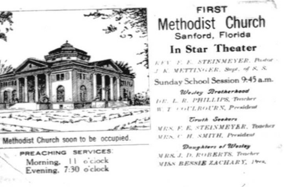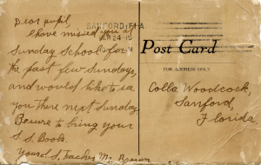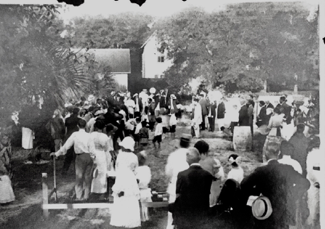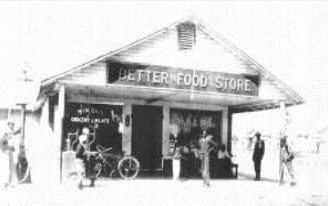It was during the Annual Conference of 1890, that Rev. Henry Hice, the minister, moved that a new location for the Sanford Church be purchased. During the ministry of Rev. T.W. Moore, in 1892, the property on the corner of Park Avenue and 5th Street was purchased.
In 1890, J.M. Lord requested the residents of Southwest Sanford build a church. He donated an acre from his property, known as Lord’s Settlement, for the church. This church was completed in August 1890 and named Ebenezer. This church became Christ United Methodist Church until it voluntarily closed on December 31, 2017, and was officially discontinued by the Conference in 2018.
Ernest Chapel had been sold during the latter part of 1889 and the proceeds from the sale were divided between the Ebenezer Church and the Sanford Church.


The church building was moved in July 1892, from Sanford Avenue to the corner of Park Avenue and Fifth Street; Rev. T.W. Moore was serving as the minister. After the move, the building was renovated, adding two rooms on the front and a steeple, This building served as the Methodist Church until the appointment of F.E. Steinmeyer in 1913. Rev. H.T. Gaines had previously urged the women of the Missionary Society to arouse interest in a new building due to the overcrowding of the present one.

The last service was held in the white wooden church on Easter Sunday 1914. The old building was torn down and services were held in the Star movie theater while the new sanctuary was being erected. The cornerstone of the new building was laid on August 11, 1914, in a ceremony led by the Sanford Lodge, No.62 F.& A. M.
The first worship service in the new sanctuary was held on October 24, 1915. The marriage of Kathleen Steinmeyer, daughter of the minister, to Frank Adams was the first wedding in the new sanctuary.
Happening in Sanford
On May 21, 1891, Henry Shelton Sanford died at the age of 67. He was buried in Shelton, Connecticut, his home state.
“The town of Goldsboro was founded in 1891 by William Clark and a group of businessmen that also included John Hurston, father of the Harlem Renaissance writer Zora Neale Hurston. It was duly incorporated by the state of Florida and operated as any other city would. Goldsboro had its own post office, schools, businesses, and its residents paid taxes to support improvements and services like fire and police. Had the town survived, it would have been the second oldest city in America established by black citizens.”¹

In 1893, thirteen members of St. James AME Church decided that they needed a place to worship in their own neighborhood of Goldsboro. St. James served as the mother church to this new church plant that would eventually become Allen Chapel AME.²
In 1911, a community called Sanford Heights succeeded from the city, citing disagreements over municipal services provided by the city of Sanford. At the time, the city of Sanford only expanded south to 13th Street, where Sanford Heights began around 15th Street. The city of Sanford was limited in growth by Lake Monroe to the north Sanford Heights to the South, Georgetown to the east, and Goldsboro to the west.
The Sanford City Commissioner wrote to the Florida Legislature and asked to have the city of Sanford Heights’ charter abolished. However, they also asked for the charters of Goldsboro and Sanford also be abolished, as they sought to redraw the city boundaries of Sanford.
“On April 6, 1911, Sanford passed a resolution of its intent to absorb Goldsboro. When the town would not voluntarily give up its charter, Forest Lake, (former Mayor of Sanford) then a state senator, persuaded the Legislature to take away the charters of Sanford and Goldsboro and reorganize Sanford to include Goldsboro. The Legislature also stopped a group of Sanford Heights residents led by Richard H. Marks from continuing efforts to incorporate that neighborhood south of Celery Avenue.
Despite impassioned pleas from the Goldsboro officials that were published in the Sanford Herald, the Legislature passed the Sanford Charter Bill on April 26, 1911….Sanford changed the names of Goldsboro’s streets, including renaming Clark Street as Lake Avenue for the man who engineered the town’s demise.”³
On February 28, 2013, Lake Ave. was renamed William Clark Ave., to honor the town’s founding father.
Happening in the world
1890 – Vincent Van Gogh, Dutch painter, committed suicide on July, 29.
1895 – In Germany, Wilhelm Roentgen developed X-Rays.
1896 – The US Supreme Court ruled the “separate but equal” public facilities for Blacks and whites was legal. Utah became the 45th state and Idaho allowed women to vote.
1897 – The first subway (underground) passenger system opened in Boston.
1898- Marie and Pierre Curie announce the discovery of an element that they name radium.
1901- William McKinley assassinated, Vice President Theodore Roosevelt becomes the 26th President of the United States,
1902 The first college football game, the Rose Bowl between Michigan and Stanford, is held in Pasadena, California.
1903- Orville Wright flies an aircraft with a petrol engine at Kitty Hawk, North Carolina, in the first documented, successful, controlled, powered, heavier-than-air flight.
1906 – Mahatma Gandhi coins the term, Satyagraha to characterize the nonviolence movement in South Africa.
1908- Henry Ford produces his first Model T automobile at the Ford Piquette Avenue Plant, in Detroit, Michigan.
1911- Hiram Bingham rediscovers Machu Picchu in Peru.
1912- RMS Titanic strikes an iceberg in the northern Atlantic Ocean and sinks with the loss of between 1,517 and 1,636 lives. The wreck would not be discovered until 1985.
- Quote from https://thebokey.com/2020/04/06/tsh-sanford-leaders-plot-demise-of-the-city-of-goldsboro/ . Information about Goldsboro’s early history also accessed from the Goldsboro Museum: https://goldsboromuseum.com/about-us/
- http://www.allenchapelsanford.com/church-history.html
- Grapeville Details Emerge – The Histories of the Swedish Colony and the Goldsboro Area are Intertwined
https://infoweb.newsbank.com/apps/news/document-view?p=WORLDNEWS&docref=news/0F7F23A84FA0D7C6&f=basic